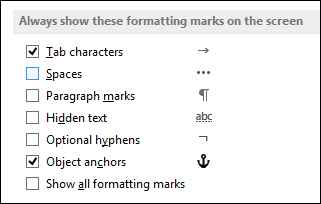

#Turn on show hide in word how to#
If you do not know how to use Track Changes, Microsoft has a very useful online guide to using Track Changes. Reviewers can then accept or reject changes. Track Changes will record any text you add, delete, reformat, or comment on. This allows us to clearly see what edits have been made and greatly speeds up the amount of time we spend editing web pages. In addition, it gives more power to the owner of the document who can accept or reject any changes made to the document.ĭigital communications often shares Word documents containing website content with colleagues across the University, and asks them to use Track Changes to make edits or queries. It is particularly useful when you are sharing documents with other colleagues, because it allows you to see exactly what changes were made, and by whom. In this post, I’ll teach you how to use Track Changes to edit Word documents, and how to accept or reject those changes as a reviewer. if you press Ctrl + Shift + 8 on your keyboard then it will either show or hide the paragraph marks.Īny changes that you make to the formatting display setting will apply to the entire document.Īre you trying to copy and paste from a different location on your computer, such as a Web browser, or a different document, but the font is wrong, or the wrong color? Learn how to paste into Word 2010 without formatting and save yourself some time and frustration.Track Changes is a tool in Microsoft Word which allows you to show any markups, changes or comments made to a document. If you are often toggling the formatting mark display on and off then you may wish to familiarize yourself with its keyboard shortcut. Some of the formatting marks that you can see in Microsoft Word include: Those marks will only display when you click the Show/Hide button again.

If you click the Show/Hide button in the Paragraph group of the ribbon then it is going to hide the formatting marks for the current document and future documents regardless of the marks that you enabled in the Word Options menu. If you see the paragraph mark, tab characters, object anchors, or other symbols in your Word document then it means that Word is currently set up to display formatting marks. By customizing the options in the “Always show these formatting marks on screen” section you can make that configuration happen. For example, you might want to be able to see hidden text, but you may wish to turn off paragraph marks in Word 2010. The second part of our guide above directs you to the Word Options menu where you can specify which formatting marks you want Microsoft Word to display. More Information on How to Hide Formatting Marks in Word 2010

Our tutorial continues below with more discussion on working with Microsoft Word formatting marks. Tip: You can add a comment to a document in Microsoft Word so that other document editors can evaluate an idea or potential change before you decide to make it. You can also go into the Word Options menu to turn off any formatting marks that had previously been configured to display on their own. However, these marks can be difficult to work with if you are unfamiliar with them, so you might decide that editing a document is simpler when they are hidden.įortunately, you can hide those formatting marks by changing a setting in Word 2010. You can choose to show that information by enabling an option that will display formatting marks. Your Microsoft Word 2010 document includes a lot of information behind the scenes that dictates how elements appear within that document. But there is one specific setting that can hide or show formatting marks in a document, and that setting will remain even after you close a document in Microsoft Word. Many of the settings in Microsoft Word will only apply to the current document unless you choose to apply a setting to the default template.


 0 kommentar(er)
0 kommentar(er)
